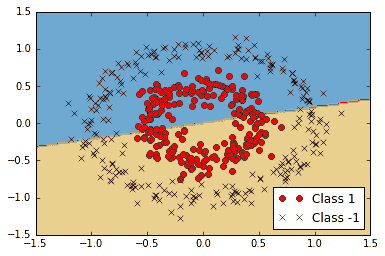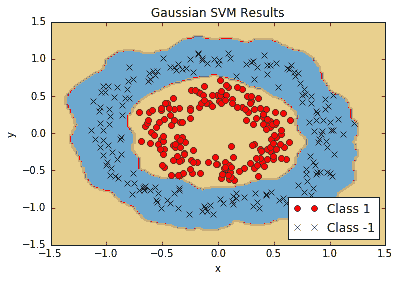# 在 TensorFlow 中使用内核
先前的 SVM 使用线性可分数据。如果我们分离非线性数据,我们可以改变将线性分隔符投影到数据上的方式。这是通过更改 SVM 损失函数中的内核来完成的。在本章中,我们将介绍如何更改内核并分离非线性可分离数据。
## 做好准备
在本文中,我们将激励支持向量机中内核的使用。在线性 SVM 部分,我们用特定的损失函数求解了软边界。这种方法的另一种方法是解决所谓的优化问题的对偶。可以证明线性 SVM 问题的对偶性由以下公式给出:

对此,以下适用:

这里,模型中的变量将是`b`向量。理想情况下,此向量将非常稀疏,仅对我们数据集的相应支持向量采用接近 1 和-1 的值。我们的数据点向量由`x[i]`表示,我们的目标(1 或 -1)`y[i]`表示。
前面等式中的内核是点积`x[i] · y[j]`,它给出了线性内核。该内核是一个方形矩阵,填充了数据点`i, j`的点积。
我们可以将更复杂的函数扩展到更高的维度,而不是仅仅在数据点之间进行点积,而在这些维度中,类可以是线性可分的。这似乎是不必要的复杂,但我们可以选择一个具有以下属性的函数`k`:

这里`, k`被称为核函数。更常见的内核是使用高斯内核(也称为径向基函数内核或 RBF 内核)。该内核用以下等式描述:

为了对这个内核进行预测,比如说`p[i]`,我们只需在内核中的相应方程中用预测点替换,如下所示:

在本节中,我们将讨论如何实现高斯内核。我们还将在适当的位置记下在何处替换实现线性内核。我们将使用的数据集将手动创建,以显示高斯内核更适合在线性内核上使用的位置。
## 操作步骤
我们按如下方式处理秘籍:
1. 首先,我们加载必要的库并启动图会话,如下所示:
```py
import matplotlib.pyplot as plt
import numpy as np
import tensorflow as tf
from sklearn import datasets
sess = tf.Session()
```
1. 现在,我们生成数据。我们将生成的数据将是两个同心数据环;每个戒指都属于不同的阶级。我们必须确保类只有-1 或 1。然后我们将数据分成每个类的`x`和`y`值以用于绘图目的。为此,请使用以下代码:
```py
(x_vals, y_vals) = datasets.make_circles(n_samples=500, factor=.5, noise=.1)
y_vals = np.array([1 if y==1 else -1 for y in y_vals])
class1_x = [x[0] for i,x in enumerate(x_vals) if y_vals[i]==1]
class1_y = [x[1] for i,x in enumerate(x_vals) if y_vals[i]==1]
class2_x = [x[0] for i,x in enumerate(x_vals) if y_vals[i]==-1]
class2_y = [x[1] for i,x in enumerate(x_vals) if y_vals[i]==-1]
```
1. 接下来,我们声明批量大小和占位符,并创建我们的模型变量`b`。对于 SVM,我们倾向于需要更大的批量大小,因为我们需要一个非常稳定的模型,该模型在每次训练生成时都不会波动很大。另请注意,我们为预测点添加了额外的占位符。为了可视化结果,我们将创建一个颜色网格,以查看哪些区域最后属于哪个类。我们这样做如下:
```py
batch_size = 250
x_data = tf.placeholder(shape=[None, 2], dtype=tf.float32)
y_target = tf.placeholder(shape=[None, 1], dtype=tf.float32)
prediction_grid = tf.placeholder(shape=[None, 2], dtype=tf.float32)
b = tf.Variable(tf.random_normal(shape=[1,batch_size]))
```
1. 我们现在将创建高斯内核。该内核可以表示为矩阵运算,如下所示:
```py
gamma = tf.constant(-50.0)
dist = tf.reduce_sum(tf.square(x_data), 1)
dist = tf.reshape(dist, [-1,1])
sq_dists = tf.add(tf.subtract(dist, tf.multiply(2., tf.matmul(x_data, tf.transpose(x_data)))), tf.transpose(dist))
my_kernel = tf.exp(tf.multiply(gamma, tf.abs(sq_dists)))
```
> 注意`add`和`subtract`操作的`sq_dists`行中广播的使用。 另外,请注意线性内核可以表示为`my_kernel = tf.matmul(x_data, tf.transpose(x_data))`。
1. 现在,我们宣布了本秘籍中之前所述的双重问题。最后,我们将使用`tf.negative()`函数最小化损失函数的负值,而不是最大化。我们使用以下代码完成此任务:
```py
model_output = tf.matmul(b, my_kernel)
first_term = tf.reduce_sum(b)
b_vec_cross = tf.matmul(tf.transpose(b), b)
y_target_cross = tf.matmul(y_target, tf.transpose(y_target))
second_term = tf.reduce_sum(tf.multiply(my_kernel, tf.multiply(b_vec_cross, y_target_cross)))
loss = tf.negative(tf.subtract(first_term, second_term))
```
1. 我们现在创建预测和准确率函数。首先,我们必须创建一个预测内核,类似于步骤 4,但是我们拥有带有预测数据的点的核心,而不是点的内核。然后预测是模型输出的符号。这实现如下:
```py
rA = tf.reshape(tf.reduce_sum(tf.square(x_data), 1),[-1,1])
rB = tf.reshape(tf.reduce_sum(tf.square(prediction_grid), 1),[-1,1])
pred_sq_dist = tf.add(tf.subtract(rA, tf.multiply(2., tf.matmul(x_data, tf.transpose(prediction_grid)))), tf.transpose(rB))
pred_kernel = tf.exp(tf.multiply(gamma, tf.abs(pred_sq_dist)))
prediction_output = tf.matmul(tf.multiply(tf.transpose(y_target),b), pred_kernel)
prediction = tf.sign(prediction_output-tf.reduce_mean(prediction_output))
accuracy = tf.reduce_mean(tf.cast(tf.equal(tf.squeeze(prediction), tf.squeeze(y_target)), tf.float32))
```
> 为了实现线性预测内核,我们可以编写`pred_kernel = tf.matmul(x_data, tf.transpose(prediction_grid))`。
1. 现在,我们可以创建一个优化函数并初始化所有变量,如下所示:
```py
my_opt = tf.train.GradientDescentOptimizer(0.001)
train_step = my_opt.minimize(loss)
init = tf.global_variables_initializer()
sess.run(init)
```
1. 接下来,我们开始训练循环。我们将记录每代的损耗向量和批次精度。当我们运行准确率时,我们必须放入所有三个占位符,但我们输入`x`数据两次以获得对点的预测,如下所示:
```py
loss_vec = []
batch_accuracy = []
for i in range(500):
rand_index = np.random.choice(len(x_vals), size=batch_size)
rand_x = x_vals[rand_index]
rand_y = np.transpose([y_vals[rand_index]])
sess.run(train_step, feed_dict={x_data: rand_x, y_target: rand_y})
temp_loss = sess.run(loss, feed_dict={x_data: rand_x, y_target: rand_y})
loss_vec.append(temp_loss)
acc_temp = sess.run(accuracy, feed_dict={x_data: rand_x,
y_target: rand_y,
prediction_grid:rand_x})
batch_accuracy.append(acc_temp)
if (i+1)%100==0:
print('Step #' + str(i+1))
print('Loss = ' + str(temp_loss))
```
1. 这导致以下输出:
```py
Step #100
Loss = -28.0772
Step #200
Loss = -3.3628
Step #300
Loss = -58.862
Step #400
Loss = -75.1121
Step #500
Loss = -84.8905
```
1. 为了查看整个空间的输出类,我们将在系统中创建一个预测点网格,并对所有这些预测点进行预测,如下所示:
```py
x_min, x_max = x_vals[:, 0].min() - 1, x_vals[:, 0].max() + 1
y_min, y_max = x_vals[:, 1].min() - 1, x_vals[:, 1].max() + 1
xx, yy = np.meshgrid(np.arange(x_min, x_max, 0.02),
np.arange(y_min, y_max, 0.02))
grid_points = np.c_[xx.ravel(), yy.ravel()]
[grid_predictions] = sess.run(prediction, feed_dict={x_data: x_vals,
y_target: np.transpose([y_vals]),
prediction_grid: grid_points})
grid_predictions = grid_predictions.reshape(xx.shape)
```
1. 以下是绘制结果,批次准确率和损失的代码:
```py
plt.contourf(xx, yy, grid_predictions, cmap=plt.cm.Paired, alpha=0.8)
plt.plot(class1_x, class1_y, 'ro', label='Class 1')
plt.plot(class2_x, class2_y, 'kx', label='Class -1')
plt.legend(loc='lower right')
plt.ylim([-1.5, 1.5])
plt.xlim([-1.5, 1.5])
plt.show()
plt.plot(batch_accuracy, 'k-', label='Accuracy')
plt.title('Batch Accuracy')
plt.xlabel('Generation')
plt.ylabel('Accuracy')
plt.legend(loc='lower right')
plt.show()
plt.plot(loss_vec, 'k-')
plt.title('Loss per Generation')
plt.xlabel('Generation')
plt.ylabel('Loss')
plt.show()
```
为了简洁起见,我们将仅显示结果图,但我们也可以单独运行绘图代码并查看损失和准确率。
以下屏幕截图说明了线性可分离拟合对我们的非线性数据有多糟糕:

图 7:非线性可分离数据上的线性 SVM
以下屏幕截图显示了高斯内核可以更好地拟合非线性数据:
Figure 8: Non-linear SVM with Gaussian kernel results on non-linear ring data
如果我们使用高斯内核来分离我们的非线性环数据,我们会得到更好的拟合。
## 工作原理
有两个重要的代码需要了解:我们如何实现内核,以及我们如何为 SVM 双优化问题实现损失函数。我们已经展示了如何实现线性和高斯核,并且高斯核可以分离非线性数据集。
我们还应该提到另一个参数,即高斯核中的伽马值。此参数控制影响点对分离曲率的影响程度。通常选择小值,但它在很大程度上取决于数据集。理想情况下,使用交叉验证等统计技术选择此参数。
> 对于新点的预测/评估,我们使用以下命令:`sess.run(prediction, feed_dict:{x_data: x_vals, y_data: np.transpose([y_vals])})`。此评估必须包括原始数据集(`x_vals`和`y_vals`),因为 SVM 是使用支持向量定义的,由哪些点指定在边界上或不是。
## 更多
如果我们这样选择,我们可以实现更多内核。以下是一些更常见的非线性内核列表:
* 多项式齐次核:

* 多项式非均匀内核:

* 双曲正切内核:

- TensorFlow 入门
- 介绍
- TensorFlow 如何工作
- 声明变量和张量
- 使用占位符和变量
- 使用矩阵
- 声明操作符
- 实现激活函数
- 使用数据源
- 其他资源
- TensorFlow 的方式
- 介绍
- 计算图中的操作
- 对嵌套操作分层
- 使用多个层
- 实现损失函数
- 实现反向传播
- 使用批量和随机训练
- 把所有东西结合在一起
- 评估模型
- 线性回归
- 介绍
- 使用矩阵逆方法
- 实现分解方法
- 学习 TensorFlow 线性回归方法
- 理解线性回归中的损失函数
- 实现 deming 回归
- 实现套索和岭回归
- 实现弹性网络回归
- 实现逻辑回归
- 支持向量机
- 介绍
- 使用线性 SVM
- 简化为线性回归
- 在 TensorFlow 中使用内核
- 实现非线性 SVM
- 实现多类 SVM
- 最近邻方法
- 介绍
- 使用最近邻
- 使用基于文本的距离
- 使用混合距离函数的计算
- 使用地址匹配的示例
- 使用最近邻进行图像识别
- 神经网络
- 介绍
- 实现操作门
- 使用门和激活函数
- 实现单层神经网络
- 实现不同的层
- 使用多层神经网络
- 改进线性模型的预测
- 学习玩井字棋
- 自然语言处理
- 介绍
- 使用词袋嵌入
- 实现 TF-IDF
- 使用 Skip-Gram 嵌入
- 使用 CBOW 嵌入
- 使用 word2vec 进行预测
- 使用 doc2vec 进行情绪分析
- 卷积神经网络
- 介绍
- 实现简单的 CNN
- 实现先进的 CNN
- 重新训练现有的 CNN 模型
- 应用 StyleNet 和 NeuralStyle 项目
- 实现 DeepDream
- 循环神经网络
- 介绍
- 为垃圾邮件预测实现 RNN
- 实现 LSTM 模型
- 堆叠多个 LSTM 层
- 创建序列到序列模型
- 训练 Siamese RNN 相似性度量
- 将 TensorFlow 投入生产
- 介绍
- 实现单元测试
- 使用多个执行程序
- 并行化 TensorFlow
- 将 TensorFlow 投入生产
- 生产环境 TensorFlow 的一个例子
- 使用 TensorFlow 服务
- 更多 TensorFlow
- 介绍
- 可视化 TensorBoard 中的图
- 使用遗传算法
- 使用 k 均值聚类
- 求解常微分方程组
- 使用随机森林
- 使用 TensorFlow 和 Keras
